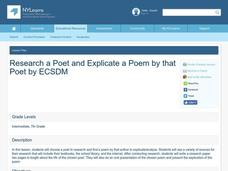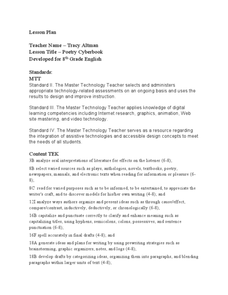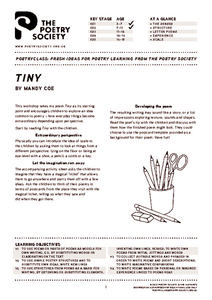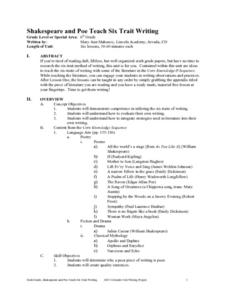Curated OER
Use of Personification and Imagery in Poetry
A reading of Theodore Roethke’s dark "Root Cellar" and Sylvia Plath’s more abstract "Mirror" launches a discussion of imagery and personification in poetry. After finding examples of personification in the poems, class members craft...
Curated OER
Giggle Poetry
Poetry can be fun! To set your pupils giggling, have them listen to poems from If Kids Ruled the School by Bruce Lansky. Then, they can study the different types of poetry on www.gigglepoetry.com, and choose one form on which to base...
Curated OER
Using Similes and Metaphors in Poetry
The use of similes and metaphors will become more clear and your students will gain knowledge and comprehend the meanings of the words with these activities. They compose interesting similes and metaphors based on visual prompts and...
Curated OER
Animal Acrostic
In this animal acrostic worksheet, students read a short poem. Afterward, they answer questions about the poem and then write their own acrostic poetry. Students share their poetry with a friend, and guess what type of animal is described.
Curated OER
Sound poems
Third graders write a class poem based on the use of sound to create effects. They investigate use of onomatopoeia and how to write in a tight structure.
Curated OER
Research a Poet and Explicate a Poem by that Poet
Seventh graders choose a poet to research and find a poem by that author to explicate/analyze using a variety of sources for their research that will include their textbooks, the school library, and the internet. After conducting...
Curated OER
Searching for Meanings Beneath the Surface of the Poem
Young scholars analyze poetry. For this cultural perspectives lesson, students read the poem "Soccer Until Dusk" by Mark Brazaitis. Young scholars analyze the poem and consider the cultural perspective it reveals.
Curated OER
Poetry Cyberbook
Emerging poets design a website and then post seven original poems as well as their written critique of these poems. Although the resource mentions Inspiration and FrontPage technologies, any software could be substituted.
Curated OER
Impersonating Great Poets Using "Science Verse" by Jon Scieszka
A great way to bring poetry and parody into your language arts classroom, this lesson mimics famous poems based on Jon Scieszka's Science Verse. The activity not only allows the class to see examples of poem parodies, but to create their...
National Park Service
The Poet's Toolbox
If you need a lesson for your poetry unit, use two poems by Henry Wadsworth Longfellow ("Rain in Summer" and "The Slave in the Dismal Swamp") and a resource on Elements of Poetry. The lesson plan guides you through activities on...
National Endowment for the Humanities
Lu Shih — The Couplets of T’ang
Writing poetry in ancient China was the modern equivalent of sending a greeting card. Scholars learn about the ancient Chinese poetic form called the lu shih. They read about the context of poetry during the T'ang Dynasty and complete a...
Poetry Society
Tiny by Mandy Coe
Introduce magic and imagination into your classroom with a poetry activity. Learners read the poem "Tiny" by Mandy Coe and use their magic tickets to visit any place they can think of! The final result is a poem describing where they...
Penguin Books
A Teacher's Guide to the Signet Classic Edition of Beowulf
Beowulf, the Old English epic hero, comes alive again in the activities found in a teacher's guide designed to accompany a reading of the classic poem.
Teach It Primary
The Pied Piper of Hamelin
Six tasks make up a lesson plan designed to reinforce comprehension and language skills using the poem "The Pied Piper" by Robert Browing. Scholars discuss and define unknown words, identify adjectives and onomatopoeia, review complex...
EngageNY
Comparing Text Structures: To Kill a Mockingbird and “Those Winter Sundays” (Chapter 6 and 7)
Scholars carry out a close read of the poem "Those Winter Sundays" to determine its point. They look at the words used and the structure of the stanzas and then compare the poem's narrative structure to chapter 6 of To Kill a...
Curated OER
Poetry Lesson
Eighth graders discuss imagery and why it is important in poetry. They read and discuss the poem Harlem by Langston Hughes. They create a web from teacher given words. They read and discuss the poems On A Night of Snow by Elizabeth...
EngageNY
Reading about Freaky Frogs: “The Amazon Horned Frog"
The Amazon Horned Frog is the focus of a activity designed to encourage readers to ask and answer questions. A frog-themed poem opens the door to a whole-group discussion. Following a read-aloud of an informational text, a three-page...
EngageNY
Finishing Who? Where? and Why? Research
Who? Where? Why? Scholars answer these questions to help identify the gist of Inside Out & Back Again. First, they add text evidence to their research folders. They then begin looking at a performance task in which they write their...
EngageNY
Analyzing an Author’s Craft: Carlotta’s Journey to Justice
Find your voice. Readers look at a passage from A Mighty Long Way and discuss what it means for Carlotta to find her voice. After discussing figurative language and idioms, learners listen to the song "This Little Light of Mine" and...
Curated OER
Lesson: Impressions
Here, Autumn Poplars is the painting upper graders will analyze. They look at techniques, time period, and the use of impressionism to convey a natural theme. They go outside to make observations of nature and use what they see to write...
Curated OER
Shakespeare and Poe Teach Six-Trait Writing
A Six-Trait Writing instructional activity helps your middle schoolers liven up their word choice and shows them how to evaluate their own writing. Class members take a close look at the language used in poems by Shakespeare, Kipling,...
Curated OER
Lesson Plan: Finding Your Path
Our art often reflects who we are as individuals and as part of a larger community. The painting Hopi Eagle Dancer reflects the history and culture of the artists who created it. Critical thinkers analyze the piece and then compose a...
Curated OER
Lesson Plan: Letting Go
Why would an artist destroy his own work? Kids examine the Malagan practice of creating and then destroying art. They talk about the cultural and spiritual significance of this practice, as well as how it relates to consumerism in...
Curated OER
Lesson Plan: Blending Observation and Imagination
Upper graders analyze the work, Bouquet of Flowers in a Vase by Maria van Oosterwyck. They consider the value of her paintings and how they are still relevent and sought after, 350 years after they were created. The blending of...

























